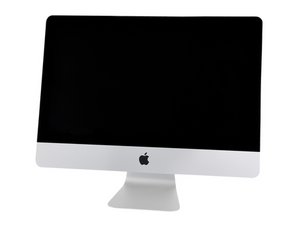@aname123 I’d start off by following what Apple suggest:
Quick Check Procedures
Resetting the System Management Controller (SMC)
The System Management Controller (SMC) is a chip on the logic board that controls all power functions. If the computer is experiencing any power issue, such as not starting up, not displaying video, sleep issues, or fan noise issues, resetting SMC may resolve it.
Note for iMacs: If you press the power button while inserting the power cord, the iMac will enter a mode in which the fans run at full speed. For more information, refer to Apple Support article TS1433: iMac: Fans run at full speed after computer turns on.
Resetting Parameter RAM (PRAM)
PRAM stores certain system and device settings in a location that OS X can access quickly. Exactly which settings are stored in the computer’s PRAM varies depending on the type of computer as well as the types of devices and drives connected. To reset PRAM:
1. Shut down the computer.
2. Locate the following keys on the keyboard: Command, Option (Alt), P, and R. You will need to hold these keys down simultaneously in Step 4.
3. Press power button.
4. Immediately press and hold Command-Option-P-R keys.
Important: You must press this key combination before the gray screen appears.
5. Hold down keys until computer restarts, and you hear startup chime a second time.
6. Release keys.
Starting Up in Safe Mode
Safe Mode is the state into which you can start up your Mac by performing a Safe Boot. Starting up into Safe Mode does several things that can help troubleshoot and resolve software or directory issues that may exist on the startup volume. To start up in Safe Mode:
1. Make sure computer is shut down.
2. Press power button.
3. Immediately after you hear startup sound, press and hold Shift key.
Note: The Shift key should be held as soon as possible after startup sound but not before.
4. Release Shift key when you see the screen with a gray Apple and progress indicator (looks like a spinning gear). Note that booting into Safe Mode will take longer than a normal startup. During startup in OS X v10.4 through OS X v10.6.8, you will see "Safe Boot" on the login window, which appears even if you normally log in automatically. In OS X v10.6 and later, a gray progress bar is also displayed on the bottom of the window during Safe Boot. During startup in OS X v10.2 through v10.3.9, you will see "Safe Boot" on the OS X startup screen.
5. To leave Safe Mode, restart computer normally, without holding down any keys during startup.
The iMac (21.5-inch, Late 2012, Early 2013, Late 2013) has four diagnostic LEDs and two pairs of test pads that can help you troubleshoot the computer without removing the logic board.
Diagnostic LEDs (A)
LED 1
Indicates that the trickle voltage from power supply has been detected by main logic board. This LED will turn ON when you connect the iMac to a working AC power source. LED will remain ON as long as the computer is ON or asleep.
When computer has been correctly shutdown, LED 1 behavior may differ:
· If a startup event is scheduled in System Preferences/Energy saver, LED 1 will stay ON after a correct shutdown.
· If no startup event is scheduled in System Preferences/Energy saver, LED 1 will turn OFF and will stay OFF as long as power cord is kept connected and AC power source is present. Disconnecting the power cord and plugging it back will turn this LED back ON , even if computer is still off.
After disconnecting and reconnecting the AC power source, this LED could remain OFF if the AC power source is missing or disconnected , if the logic board is disconnected from the power supply or from the AC receptacle, or if the power supply board is faulty.
LED 2
Indicates that computer is turned on. This LED will be ON as long as computer is turned on (but is not asleep) and power supply and voltage regulators are working correctly.
LED 3
Indicates that computer and the GPU are communicating. This LED will be ON when computer is communicating properly with the GPU. If LEDs 1 and 2 are ON and you heard the startup sound, but LED 3 is OFF, then the backup battery (on back of logic board) may need to be reseated, or the logic board might need replacement.
LED 4
Indicates that computer and LCD panel are communicating. This LED will be ON when computer is turned on and video signal is being generated. If LED 4 is ON and there is no image on display, then the LCD panel or the cables between LCD and logic board might be installed incorrectly, or need replacement.
LED Startup Sequence
LED 1 = Power available.
If no LED is visible:
· Disconnect the power cord from computer and wait 15 seconds to reset the power supply and LED status. Reconnect the power cord and check the LED status again.
· Verify AC source.
· Verify known-good power cord is connected.
· Verify cable connection between AC inlet and power supply.
· Verify cable connection between power supply and logic board.
· Verify power supply.
LED 1 + LED 2 = Power available, and system is powered on.
If second LED is not visible when power button is pressed:
· Verify power button connection to power supply.
· Verify power button functionality.
· Verify cable connection between power supply and logic board.
· Verify power supply.
· Verify logic board.
LED 1 + LED 2 + LED 3 = Power available, system is powered on, and GPU found.
If third LED is not visible after power on:
· Verify if boot chime is present and fans are running when powered ON (reset SMC and PRAM, verify backup battery
· voltage for proper boot up):
· If POST boot chime is not heard, go to No Startup symptom flow.
· If POST boot chime is heard, go to No Video symptom flow.
LED 1 + LED 2 + LED 3 + LED 4 = Power available, system is powered on, logic board is communicating with the GPU, and internal LCD found.
If fourth LED is not visible after power on:
· Verify internal DisplayPort cable connections between LCD panel and logic board.
· Inspect LCD display cables for cable damage.
· Verify external video functionality, and according to result check the following items:
· If external display works then verify/replace the LCD panel.
· If external display does not work verify/replace the logic board.
Attached is the flowsheet for the No Power and the NO Start Up symptoms for your iMac.IMac No Power No Load Since the fan did NOT come on etc, I would focus on the diagnostic LED’s and see what they show. Of course, you can always take it to someone else and have it diagnosed and/or repaired. Let us know what you find.

 1
1  1
1 
 2.4千
2.4千 

2条评论
It is possible that the power for the LED back lights may have blown a fuse. you can check it and the capacitors to get a better idea what is going on.
由 stressmaster 完成的
When a black screen occurs, there are many things to consider, including problems with hardware or software.
由 Computer Krayzee 完成的